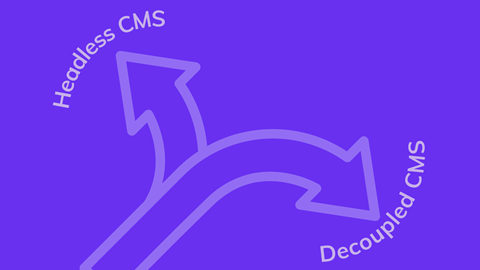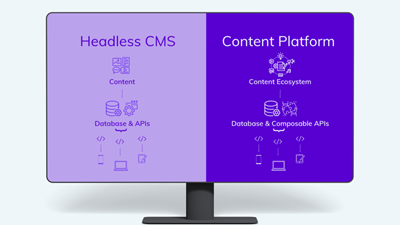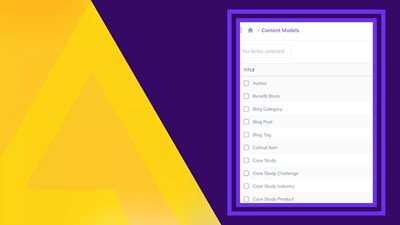Headless CMS vs Decoupled CMS: In Layman’s Terms


Two notable approaches to modern content management systems (CMS) have emerged: headless CMS and decoupled CMS. While both have advantages over traditional monolithic CMS, headless CMS is the clear winner for enterprises looking for unrivalled flexibility, scalability, and agility; but what do these systems 'truly' mean and is there an actual difference that impacts marketers/ the end user?
Understanding the Differences: Headless CMS vs. Decoupled CMS
To fully appreciate the benefits of headless CMS, it's essential to understand how it differs from decoupled CMS. While both approaches separate the frontend and backend, they vary in their architectural nuances and the extent of coupling between the two layers.
Backend and frontend separation:
The primary differentiation between headless CMS and decoupled CMS is how the front and back end interact.
Headless CMS totally separates the backend (content generation and storage) from the frontend (content presentation), revolutionizing content management. In a headless CMS, the backend is responsible for creating, storing, and retrieving content. It delivers material using APIs (interfaces that enable different systems to communicate with one another). The frontend layer, on the other hand, which is responsible for displaying the content, can be constructed separately. This implies that you may present your content on any platform, including websites, mobile apps, IoT devices, and more.
The backend of a decoupled CMS manages both content creation and storage, as well as content delivery via built-in templating systems or frontend frameworks. While the frontend layer can be customized to some extent, it is intrinsically connected to the predetermined design of the CMS.
Is one better than the other? To couple or de-couple?
The decision to couple or decouple the frontend and backend depends on your specific needs. Coupling offers simplicity and faster development but limits flexibility, while decoupling provides flexibility, scalability, and the ability to leverage new technologies at the cost of increased complexity.
Agility's headless CMS addresses the complexity often associated with typical headless CMS solutions in several ways:
-
User-Friendly Interface: Agility prioritizes providing customers with a user-friendly interface for simplifying content management.
-
Content-First Approach: Agility focuses on empowering content creators and marketers by placing content at the center of its CMS. It offers features like content modeling, reusable content modules, and content scheduling.
What is Meant By Flexibility and How Do the Two Differ?
When discussing headless vs. decoupled CMS, "flexibility" refers to the degree of freedom and adaptability that the system provides, ex: technology choices, user experiences, and future scalability.
With a headless CMS, you may use any technology you want to develop the part of your website or app that customers see. Different programming languages or systems can be used to generate distinct and customized experiences across multiple devices.
You still have some flexibility in a decoupled CMS, but it is somewhat constrained. You can customize the frontend by selecting from a range of options offered by the CMS, but you don't have as much freedom to utilize any technology you want.
In layman's terms, flexibility means being able to select the best tools and customize your website or app to create the experience you desire for your users, whether it's a completely open choice in a headless CMS or a more restricted choice in a decoupled CMS.
Why Agility Excels as a Headless CMS Solution:
Among the numerous headless CMS choices available, Agility stands out as the clear winner. Here are some of the reasons why Agility is the greatest choice for firms looking to enter the headless CMS space:
- Effective Content Management: Agility provides content creators and marketers with an easy, feature-rich content management interface. It streamlines and streamlines the process of developing, organizing, and delivering content across many media.
- Powerful Developer Tools: Agility provides comprehensive APIs, SDKs, and developer-friendly documentation to developers. This enables development teams to capitalize on the full potential of headless CMS, allowing them to build dynamic and engaging experiences while ensuring efficient workflows and seamless integrations with other systems.
- Extensive Scalability: The cloud-based infrastructure used by Agility ensures excellent scalability and reliability. As your company expands and traffic increases, Agility's headless CMS can easily handle the load, ensuring a seamless user experience even during peak moments.
- Versatile Content Delivery: Agility allows businesses to distribute content across a variety of channels, including websites, mobile apps, digital signage, IoT devices, and more. The ability to reach out to audiences across numerous platforms increases customer engagement and broadens the reach of your content.
- Integration Ecosystem: Agility connects effortlessly with a broad ecosystem of third-party tools and services, allowing enterprises to employ their preferred technology. Agility promotes efficient interoperability of e-commerce platforms, marketing automation systems, analytics tools, and other solutions, allowing organizations to build a full digital ecosystem adapted to their specific needs.
Considering Your Choices: Decoupled vs Headless CMS
In today's digital landscape, when personalized and immersive experiences are critical, organizations require a content management system with unparalleled flexibility, scalability, and agility. With its explicit separation of backend and frontend, headless CMS lays the groundwork for creating dynamic and engaging digital experiences across different channels. Agility emerges as the ideal headless CMS system, providing businesses with comprehensive content management features, robust developer tools, extensive scalability, diverse content distribution, and seamless interfaces. Businesses can unlock new possibilities, future-proof their digital ecosystem, and stay ahead in the ever-changing digital landscape by embracing Agility's headless CMS.

About the Author
Harmonie is the Senior Marketing Manager at Agility CMS


